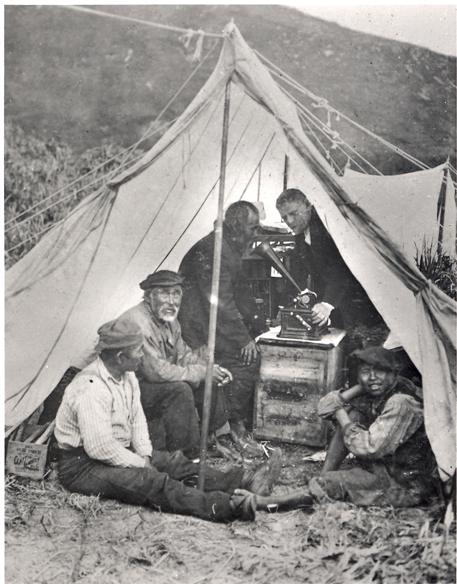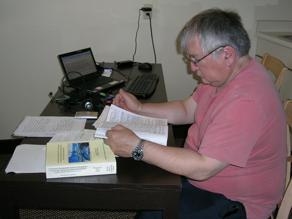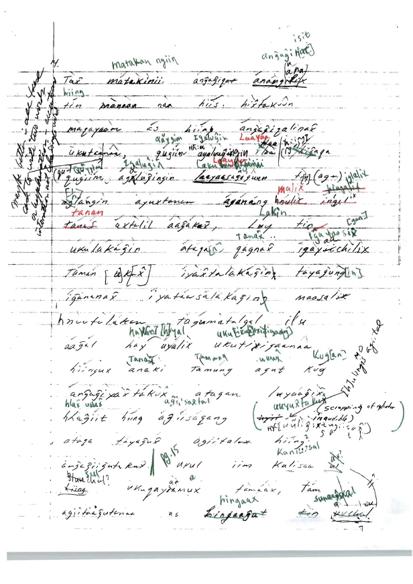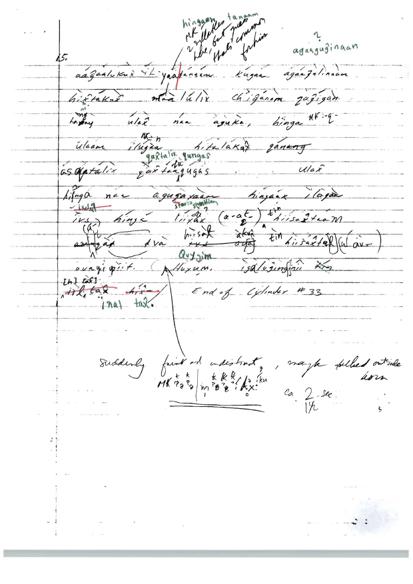E. Golovko: Attuan Aleut, Alaska Russian
Attuan Aleut Transcription with Moses Dirks: 1909 Cylinder Recording
Background
Waldemar Jochelson (1855-1937) was a Russian anthropologist known for his studies of the Koryak, Yukaghir and Yakut peoples of Eastern Siberia and the Aleut of Alaska.
Born and educated in Russia, as a student Jochelson was also a revolutionary, a fierce believer in the free will of the people. In exile in remote eastern Siberia for 10 years, Jochelson spent his time writing down his observations and learning the language of the indigenous people. The authorities were so impressed they sent him on his first expedition, the Yakut-Siberian Expedition of the East Siberian Branch. This work led to publications describing the lives of the people of this northland, something that had never been done before but would continue thereafter.

Evgeny Golovko

Russian linguist, Evgeny Golovko has worked extensively with Attuan Russian Creole as well as Atkan on the Commander Islands, Russia. During the summer of 2009, Golovko and his assistant Moses Dirks set off on their mission to Atka to work on the wax cylinder recordings with the last speaker of Attuan Aleut, John Golodoff, age 80. Unfortunately, they never made it, due to the adverse weather conditions so common to that part of the Aleutians. At the very same time in Attu, Golodoff fell seriously ill then died in two weeks time The work on transcribing was then left to Golovko and Dirks. While waiting to get back home from their fated field trip, these two started on the work of transcribing ancient texts describing a life lived long ago.
Moses Dirks

In 1990, Atkan language expert, Moses Dirks transcribed many Atkan and Eastern Aleut cylinders with Norwegian linguist Knut Bergsland. Moses Dirks of Atka, one of the youngest speakers of Aleut, has worked with the Aleut language and literature for the past 30 years.
Bergsland died while working on the recordings, so the Attuan Aleut recordings were only partially transcribed .
Excerpt from Attuan Aleut Fieldnotes, Summer 2010


Update
Final fieldtrip took place September 2012. Golovko flew into Fairbanks, met with Krauss then traveled to Anchorage to work intensively with Dirks, further refining the transcription and develop final apparatus. Final deliverable is due October 2013,
Alaska Russian
Alaska was a Russian colony until 1867. The colony was ruled not by a government but by the Russian-American Company (RAC). When service was completed, there were Russian colonists that decided not to go back to their motherland. These people settled in one of the two retirement villages - Ninilchik on the Kenai Peninsula and Afognak, located on the Kodiak Archipelago. This linguistic work documents the language descended from those Afognak villagers.
During the summers of 2008 and 2009, Evgeny Golovko worked on documenting and describing what was left of the language of Russian America. His fieldwork sent him to Kodiak Island,and the Kenai peninsula in Alaska and Seattle, Washington.Fieldwork was completed in summer 2009.
As s result of the use of 'continuous recording' method of data collection, Golovko was able to capture a considerable amount of recorded material. All recorded information, including paper copies of all notebooks is stored in the Alaska Native Language Archive. Golovko has a preliminary draft of the final product completed.
According to Golovko, there are unique vestiges of the Russian language still in existence. It was found that Kodiak like Ninilchik is not creole (much affected by Alaska Native languages), but an interesting dalect of Russian. Golovko questions," if it(the language) is still alive," this is an"open ended subject."
PI Krauss comments that "other people, other linguists, e.g., Andri Kibrik, and other members of the Ninilchik community itself, e.g., Wayne Leman are involved in local projects and those local projects need to be combined with Golovko's." At present, plans for future research collaboration are being discussed.
Work in progress available online on the Michael E. Krauss Alaska Native Language Archive website.
Alaska Russian field recordings
Emel'ianova Fileslip Transliteration
Golovko has also been involved in researching older Siberian Yupik materials collected by the late Nina Emel'ianova. The extensive lexicon, some 30,000 file slips, is stored at the Institute for Linguistic Studies in St. Petersburg, Russia.
The 30,000 fileslips contain lexical material in four Eskimo languages, e.g. Chaplinski, Naukanski, Sirenski and Imaklikski. The fileslips were in need of sorting, digitization, in preparation for future documentation and research. Golovko headed this project from November 2008 - July 2009 and February - August 2011.
2008 - 2009
The first stage of this project was conducted in November 2008 - July 2009. During that period all the Emelyanova materials were sorted into two groups of (1) and (2) less importance. The priority group boxes consisted of Chaplino Yupik verbs describing emotional state and unknown Naukan words. This approach was suggested by PI Krauss.A large number of fileslips was discovered containing parallel entries in Chaplino Yupik, Naukan and Sirenik, many of which did not seem to be found in the dictionaries.


